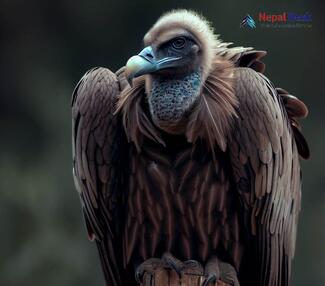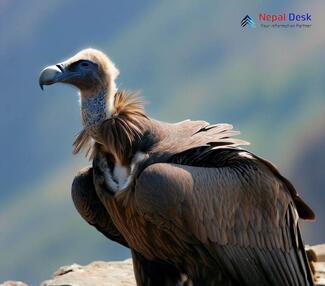Nepal, a country renowned for its breathtaking landscapes and rich biodiversity, has long been a paradise for birdwatchers and wildlife enthusiasts alike. Among the numerous species of birds that call this country home, one of the rarest and most fascinating is the Cinereous Vulture (Aegypius monachus). This large raptor is part of the Accipitridae family and can be found throughout much of temperate Eurasia. Additionally, it is referred to as the black vulture, monk vulture, or Eurasian black vulture. It holds the title of being both the largest Old World vulture and the largest member of its family, Accipitridae. It shares only a distant relation with New World vultures, which are part of the separate Cathartidae family within the same order.
The term Aegypius comes from the Greek word for 'vulture' or a bird resembling one. Aelian identified the aegypius as being halfway between a vulture (gyps) and an eagle. While some experts believe this description suits a lammergeier, others disagree. The species' eponym, Aegypius, stems from its ancient Greek origins. In English, it is called 'black vulture' due to its plumage color and 'monk vulture' since its bald head and neck feathers are reminiscent of a monk's cowl. Consequently, its German name, Mönchsgeier, directly translates to monk vulture. The term 'cinereous vulture,' derived from the Latin word cineraceus meaning ash-colored or pale whitish-gray, was an intentional effort to distinguish it from the American black vulture (Coragyps atratus).
These birds can boast a wingspan extending up to 3 meters (10 feet), easily setting them apart from other birds in the sky. The species gets its name from its ashy-gray plumage which contrasts with the dark, featherless head.
One of the primary habitats of the Cinereous Vulture is Nepal's thriving ecosystem. This includes protected areas like Sagarmatha National Park in the Khumbu region and Annapurna Conservation Area: both well-known for offering prime bird-watching opportunities. These conservation areas serve as crucial protection zones for these remarkable birds, ensuring their survival amidst increasing habitat destruction and human encroachment.
As scavengers, Cinereous Vultures play a critical role in maintaining ecosystem health by cleaning up carcasses and controlling disease spread. They rely on their keen eyesight and acute sense of smell to locate food from great distances. Their diet primarily consists of carrion – deceased animals – which they can easily break down using their powerful beaks and sharp talons.
Unfortunately, like many other vulture species worldwide, Cinereous Vultures face numerous threats to their survival. These include habitat loss, poisoning from contaminated prey, and human persecution due to misconceptions about their roles in ecosystems. Consequently, the International Union for Conservation of Nature (IUCN) has classified these vultures as Near Threatened, emphasizing the need for urgent conservation efforts.
To protect Cinereous Vultures and other vulnerable wildlife, it is essential for both the Nepalese government and international organizations to continue supporting conservation initiatives. Additionally, educating local communities about the importance of these birds and promoting sustainable ecotourism can go a long way in ensuring these vultures’ future existence.
In conclusion, the Cinereous Vulture is an essential part of not only Nepal's avian diversity, but also its globally crucial ecosystems. For those fortunate enough to catch a glimpse of this magnificent bird soaring above the country's spectacular landscapes, the experience is undoubtedly awe-inspiring. By working together to safeguard their habitats and promote awareness of their role in nature, we play our part in securing a brighter future for this majestic creature.




